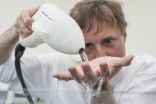Mayo researchers identify protein -- may predict who will respond to PD-1 immunotherapy for melanoma
2015-09-16
(Press-News.org) ROCHESTER, Minn. - Mayo Clinic researchers have identified a protein marker whose frequency may predict patient response to PD-1 blockade immunotherapy for melanoma. An abstract of their findings was presented today at the American Association for Cancer Research International Cancer Immunotherapy Conference in New York City.
"The discovery of biomarkers of sensitivity are vital not only for informing clinical decisions, but also to help identify which patients with melanoma, and possibly other malignancies, who are most likely to benefit from PD-1 blockade," says Roxana Dronca, M.D., a hematologist at Mayo Clinic and lead author of the abstract. "This will allow us to expose fewer patients to inadequate treatments, and their associated toxicities and costs."
The marker, Bim, is a protein that helps coordinate programmed cell death. This is a natural process that occurs in many cells, including T cells, a subset of immune cells that can recognize and kill tumor cells. Interaction of a molecule called PD-1 on T cells with a molecule called PD-L1 activates Bim and can induce T cell death. Tumors can exploit this process by overexpressing PD-L1 and killing T cells that could recognize and eliminate them.
In an effort to overcome the problem of tumors evading the immune system, researchers have generated biological molecules that block PD-1 from interacting with PD-L1. These PD-1 blockers have shown promise results in some cancer patients, but not others - prompting a search for markers that could predict how patients will respond to the molecules before treatment.
"If I know that a patient has a very high likelihood of responding to anti-PD-1 therapy, I'm going to be more inclined to recommend that treatment and feel better about the choice," Dr. Dronca says.
Researchers found that metastatic melanoma patients who responded to PD-1 blockade with pembrolizumab had more tumor-targeting T cells expressing Bim and PD-1 in their blood prior to therapy than did patients who did not respond. They also observed that this trend reversed after weeks of treatment suggesting that proportions of these cells can be measured to help clinicians decide which patients should and should not be treated with PD-1 blockade.
They also discovered that responders had higher levels of soluble PD-L1 in their blood prior to treatment. This suggests that PD-1 blockade is most effective when the PD-1:PD-L1 interaction plays a major role in disease - a finding that improves scientific understanding of the therapeutic mechanism of PD-1 blockade.
INFORMATION:
About the Mayo Clinic Cancer Center
As a leading institution funded by the National Cancer Institute, the Mayo Clinic Cancer Center conducts basic, clinical and population science research, translating discoveries into improved methods for prevention, diagnosis, prognosis and therapy. For information on cancer clinical trials, call 1-855-776-0015 (toll-free).
About Mayo Clinic
Mayo Clinic is a nonprofit organization committed to medical research and education, and providing expert, whole-person care to everyone who needs healing. For more information, visit http://www.mayoclinic.org/about-mayo-clinic or http://newsnetwork.mayoclinic.org/.
ELSE PRESS RELEASES FROM THIS DATE:
2015-09-16
The oil and gas extraction method called hydraulic fracturing remains controversial for multiple reasons, one of which is its water use. But, as scientists report in ACS' journal Environmental Science & Technology Letters, water requirements for the process are potentially lower than those for some other energy-related extraction methods.
Since oil and gas companies ramped up hydraulic fracturing, or fracking, to unlock oil and gas from shale and tight oil formations, reports of earthquakes and contaminated water near wells proliferated. Some environmental experts have ...
2015-09-16
Detecting breast cancer in women with dense mammary tissues could become more reliable with a new mammogram procedure that researchers have now tested in pre-clinical studies of mice. In their report in the journal ACS Nano, they describe injecting gold nanoparticles in mammary tissue to enhance the imaging of early signs of breast cancer.
Mammography remains the clinical gold standard of screening tests for detecting breast cancer. However, a recognized limitation of this X-ray procedure is that dense breast tissue shows up as white masses and fibers on an image, ...
2015-09-16
Citizen science is taking off and could make a difference at regional and national regulatory levels. But not everyone thinks that's a good idea. The cover story of Chemical & Engineering News (C&EN), the weekly newsmagazine of the American Chemical Society, delves into the progress of the budding movement, as well as the pushback.
Steven K. Gibb, senior editor at C&EN, reports that in some states, regulators actively encourage and support local residents' participation in environmental monitoring. For example, Maryland's Department of the Environment and Department ...
2015-09-16
Fossils tell amazing stories and inspire them, too -- just think of this summer's "Jurassic World" blockbuster. But because some of the processes that preserve fossils are not well understood, there's still more information that they could reveal. Now scientists report in ACS' journal Analytical Chemistry a new way to probe fossils to find out how these ancient remains formed in greater detail than before.
When most organisms die, they biodegrade and leave little behind. But if they get trapped in sediments that harbor few bacteria and loads of dissolved minerals, they ...
2015-09-16
Coughing. A sore throat. Maybe a pain in your chest as you take a deep breath.
These are all common symptoms for many city-living Australians when smog levels are high. And while it is well understood that smog can cause such problems, new research has for the first time given us a glimpse as to what might be happening at the molecular level.
The University of Melbourne's Professor Richard O'Hair, from the School of Chemistry's Bio21 Institute, in collaboration with Professor Stephen Blanksby (from the Queensland University of Technology and formerly the University ...
2015-09-16
Researchers from the University of Southampton have demonstrated how a pioneering ultrasonic device can significantly improve the cleaning of medical instruments and reduce contamination and risk of infection.
StarStream, invented and patented by the University of Southampton and in commercial production by Ultrawave Ltd., makes water more efficient for cleaning by creating tiny bubbles which automatically scrub surfaces. The device supplies a gentle stream of water through a nozzle that generates ultrasound and bubbles, which dramatically improve the cleaning power of ...
2015-09-16
This news release is available in German.
Platinum is a great catalyst and can be used for many different applications. It's expensive stuff though, so tiny platinum nanoparticles sitting on cheap metal oxide materials are used to convert harmful carbon monoxide into carbon dioxide. Using scanning tunnelling microscopes, scientists at TU Vienna have now been able to image the catalytic behaviour of platinum sitting on iron-oxide, which allowed them to explain the process on an atomic scale. Surprisingly, the chemical reactions do not take place on the platinum ...
2015-09-16
Researchers at the University of Birmingham have shown how the development of coated silica nanoparticles could be used in restorative treatment of sensitive teeth and preventing the onset of tooth decay.
The study, published in the Journal of Dentistry, shows how sub-micron silica particles can be prepared to deliver important compounds into damaged teeth through tubules in the dentine.
The tiny particles can be bound to compounds ranging from calcium tooth building materials to antimicrobials that prevent infection.
Professor Damien Walmsley, from the School of ...
2015-09-16
This news release is available in German.
Topical research experiments are often too expensive or too complex to be rebuilt and incorporated in teaching. How can one, nevertheless, make modern science accessible to the public? This challenge was tackled in the research group Quantum Nanophysics led by Markus Arndt at the University of Vienna. For the first time, two research laboratories were created as complete, photorealistic computer simulations allowing university and high-school students as well as the general public to virtually access unique instruments. ...
2015-09-16
EUGENE, Ore. -- (Sept. 16, 2015) -- New research at the University of Oregon finds that an organization's logo on a food product can trigger quick perceptions by consumers about an item's healthiness and influence their decision-making.
That perception also may be seen as an endorsement that may not exist, say study co-authors Elizabeth Minton of the University of Wyoming and T. Bettina Cornwell, the Edwin E. & June Woldt Cone Professor of Marketing in the Lundquist College of Business at the UO.
The research, led by Minton as part of her doctoral dissertation at the ...
LAST 30 PRESS RELEASES:
[Press-News.org] Mayo researchers identify protein -- may predict who will respond to PD-1 immunotherapy for melanoma



